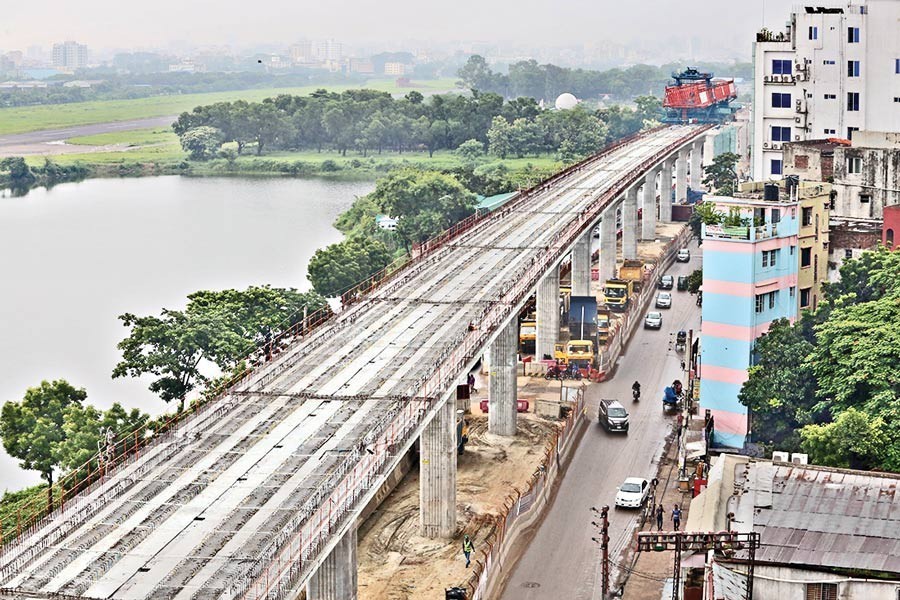How is Dhaka's transport system set to look like after a decade? Will the roads remain clogged during peak hours, causing untold sufferings to the commuters?
Will experts continue to count the economic toll that the worst traffic situation takes on the economy?
These questions and a few more might be agitating the minds of many looking at the under-construction metro rail routes, the elevated expressway and some other cost-intensive mega transport sector projects in the planning stage.
It is difficult to say right at this moment what the situation will be. It is, however, certain that movement for some people living in areas along the metro rail routes would be fast, safe and easy.
The Mass Rapid Transit (MRT)-6 that connects Uttara with Kamalapur is now under construction. This route is expected to be operational partially by the end of the current calendar year. Five more routes are planned to connect the main city points with many suburban areas.
After a long delay, the work on the first phase of the Dhaka elevated expressway (DEE), a public-private partnership (PPP) project, is now in progress, though at a higher cost. The first phase of the project that was inaugurated in 2011 is scheduled to be completed at the end of 2021. The completion of the full project between Shahjalal International Airport and Kutubkhali on Dhaka-Chattogram Highway is likely to go beyond the revised schedule.
Another major expressway running between Ashulia and Dhaka is underway. The cost of the project has been estimated at Tk 170 billion. The China EXIM Bank has agreed to provide a loan amounting to Tk 160 billion for the project and the government will provide the rest from its coffer.
Now, there are media reports that the government is planning to build another huge project--- the 11-tunnel Tongi-Sadarghat subway. It has approached the Republic of Korea to bankroll the project.
The underground and over-the-head railways, when completed, would undeniably lessen the sufferings that thousands of commuters face daily.
The expressways would charge the vehicles of all types in exchange for trouble-free plying. Not all vehicles will be interested to pay the same and they might choose the roads beneath.
Now the question is: with all the structures being built at a huge cost will there be a notable change in the traffic scenario on the streets of Dhaka? Will the buses and rickshaws ply in an orderly manner?
Some people tend to believe that with the introduction of metro rails, many middle-class families would stop using cars as it would cut both cost and time.
In the changed setting, what will happen to the passenger buses and rickshaws? Will their number go down or continue to increase as ever?
The population of Dhaka will continue to bulge unabatedly. So, demand for transports will also keep on rising. In such a situation, the number of buses, rickshaws, auto-rickshaws and motorbikes will also go up since modern transports like trains using aerial and underground routes would be able to meet only a partial demand.
If the present traffic management system persists in the years to come, there will be no let-up in the horrible experiences that the commuters have been encountering for decades.
The pitiable state of the city's traffic system does not need any elaboration as all are familiar with it. Since traffic was thin during the peak pandemic days, the situation was better. As most vehicles are back on the streets in recent days, the commuters' sufferings have also gone to the previous level.
As far as the city's traffic management is concerned, it is more or less a free-for-all situation. A modern city is supposed to have efficient traffic management, but, unfortunately, no government has been able to put in place one. Traffic movement is controlled manually in almost all parts of this capital city.
It is not that there is a scarcity of resources or appropriate pieces of legislation. A country that can build several high-cost mega infrastructures is surely capable of spending the money needed to modernise the traffic system of its capital city. What has been missing is the will to right all the wrongs relating to the city's traffic and transport systems.
Buses that dominate the city streets wilfully break relevant laws and rules. Both owners and workers are to share the blame. The present government has adopted a tough transport law but to no effect. With the relevant authorities remaining reluctant to enforce their provisions against the errant transport workers and owners, the anarchy on the streets is continuing as before.
Why blame the buses only? More than 90 per cent of rickshaws have been plying the city streets illegally. The city corporations have never tried to remove those, maybe, for humanitarian reasons. But had they been tough from the beginning, the problem would not have reached the present level. Besides, it would also have discouraged a large number of poor people from coming to Dhaka from the rural areas in search of easy employment opportunities such as rickshaw pulling. The proliferation of motorbikes in recent years has also aggravated the traffic situation.
So, with all the big transport projects coming into operation soon, the traffic situation in the city's traditional road network is unlikely to improve unless and until the relevant parties mean business.


